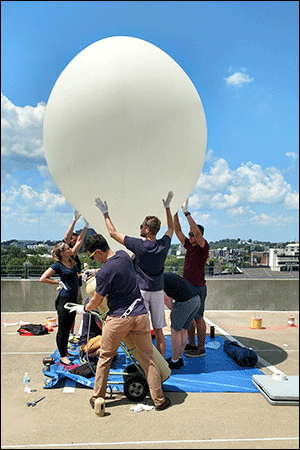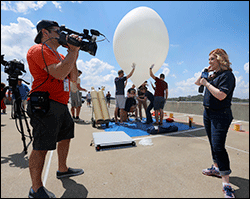A second high-altitude weather balloon rose yesterday from a Vanderbilt garage rooftop to the edge of space to live-stream video of the first total solar eclipse in the United States since 1979.

After losing the first balloon to high winds, mechanical engineering graduate student Adam Jarrell and the NASA eclipse project team quickly attached the backup balloon and successfully launched about 30 minutes before totality – 1:27 p.m. in Nashville.
Striking video was streamed to a NASA website from around 70,000 feet.
Today, they declared the launch a success and the team is going over spectacular videos and photographs from the flight and analyzing data.
“The success is due to the fast action of the team. The spare balloon was rigged and inflated in about 15 minutes. We were only 5 minutes outside of our ideal launch time,” said Jarrell, team leader of the school’s NASA Space Grant Ballooning Project.
“Thankfully, the payload was not lost when the first balloon broke free. The second balloon rose above 73,000 feet before returning to Earth south of Watertown, Tennessee, just a couple of miles south of the location of our last test flight,” Jarrell said.

Vanderbilt’s School of Engineering team has been taking part in the NASA ballooning project — a nationwide effort to livestream the solar eclipse to the National Aeronautics and Space Administration, and on Monday 55 weather balloons were released from Oregon to South Carolina as a part of that project – a feat that’s never been done before.
Vanderbilt’s other partners are the Tennessee Space Grant Consortium and the National Oceanic and Atmospheric Administration.

The recovery team – with the aid of onboard GPS tracking – quickly found the payload. “This time we didn’t have to use an arborist’s bucket truck to get to the payload,” Jarrell said. The payload on two previous test flights landed high in trees, one nearly 75 feet in the air.
“I cannot thank my colleagues enough for the time they volunteered to make the launch a success,” Jarrell said. He recognized Tom Delker and the DeKalb/Cannon County Amateur Radio Club for providing an outstanding service in their immediate response to the recovery of the balloon.
“They accomplished something unseen in my experience ballooning in middle Tennessee: A same day recovery.”
The 12-pound payload included the requisite onboard video camera to stream the eclipse to a NASA eclipse website as well as a tracking system and an amateur radio repeater that the Vanderbilt Amateur Radio Club used to communicate with fellow radio operators across the southeastern United States.
An atmospheric sensor package intended to measure changes in the Earth’s atmosphere caused by the rapid cooling when the sun was obscured also was part of the payload. These measurements will be used in research undertaken by Susan Stewart, adjoint assistant professor of astronomy. Stewart also has an appointment with the U.S. Naval Observatory in the Astronomical Applications Department where she has been an astronomer since 1997.
“The balloon’s amateur radio repeater was a big hit,” said Tim Holman, VUARC adviser and research associate professor of electrical engineering and computer science. “We had contacts or reception reports from ham radio operators in Tennessee, Ohio, Illinois and Georgia.”
“Given that the repeater was built using a couple of inexpensive compact hand held transceivers connected to a Raspberry Pi (a tiny, single-board computer), we got a lot of bang for the buck with the flight,” Holman said.
“Overall, the launch and flight went extremely well and exceeded our expectations thanks to the efforts of many dedicated students in the School of Engineering,” he said
NASA geared up to observe the eclipse with at least half a dozen instruments — high-altitude weather balloons included. Because of this accessibility, it promises to be the most-viewed and photographed eclipse of all time.
Contact:
Brenda Ellis, (615) 343-6314
Brenda.Ellis@Vanderbilt.edu
Twitter @VUEngineering